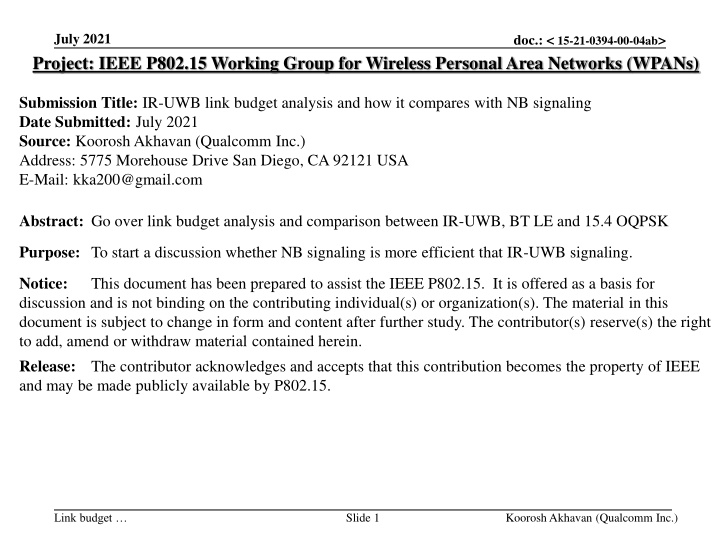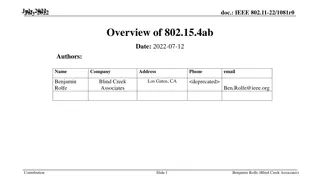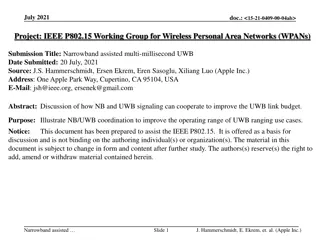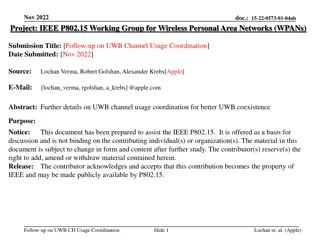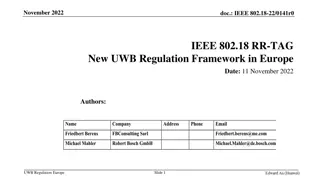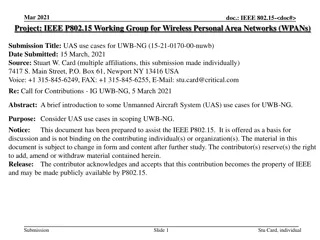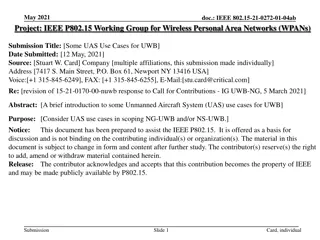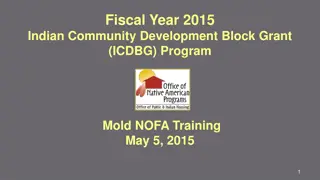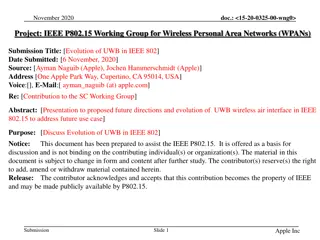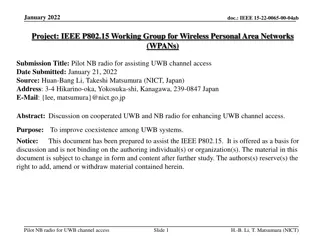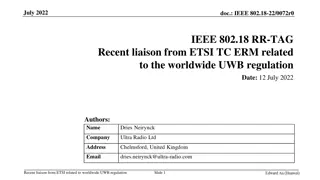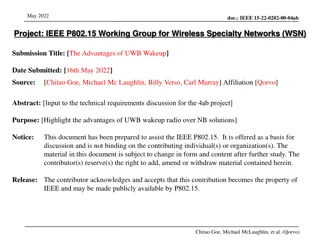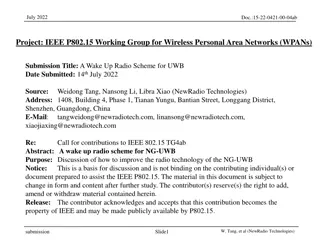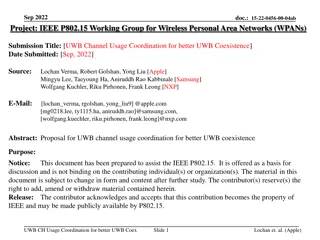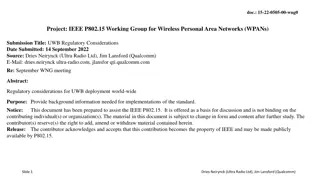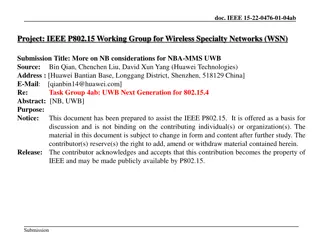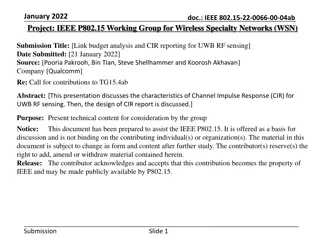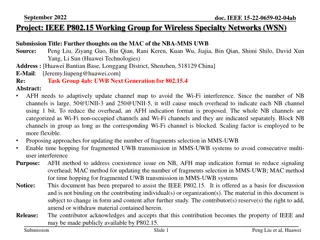IR-UWB Link Budget Analysis Comparison
This document discusses the link budget analysis of IR-UWB technology and compares it with NB signaling schemes like BT-LE and 15.4 OQPSK. It explores the efficiency and potential of narrowband signaling for wireless personal area networks.
Download Presentation

Please find below an Image/Link to download the presentation.
The content on the website is provided AS IS for your information and personal use only. It may not be sold, licensed, or shared on other websites without obtaining consent from the author.If you encounter any issues during the download, it is possible that the publisher has removed the file from their server.
You are allowed to download the files provided on this website for personal or commercial use, subject to the condition that they are used lawfully. All files are the property of their respective owners.
The content on the website is provided AS IS for your information and personal use only. It may not be sold, licensed, or shared on other websites without obtaining consent from the author.
E N D
Presentation Transcript
July 2021 Project: IEEE P802.15 Working Group for Wireless Personal Area Networks (WPANs) doc.: < 15-21-0394-00-04ab> Submission Title: IR-UWB link budget analysis and how it compares with NB signaling Date Submitted: July 2021 Source: Koorosh Akhavan (Qualcomm Inc.) Address: 5775 Morehouse Drive San Diego, CA 92121 USA E-Mail: kka200@gmail.com Abstract: Go over link budget analysis and comparison between IR-UWB, BT LE and 15.4 OQPSK Purpose: To start a discussion whether NB signaling is more efficient that IR-UWB signaling. Notice: discussion and is not binding on the contributing individual(s) or organization(s). The material in this document is subject to change in form and content after further study. The contributor(s) reserve(s) the right to add, amend or withdraw material contained herein. Release: The contributor acknowledges and accepts that this contribution becomes the property of IEEE and may be made publicly available by P802.15. This document has been prepared to assist the IEEE P802.15. It is offered as a basis for Slide 1 Koorosh Akhavan (Qualcomm Inc.) Link budget
July 2021 doc.: < 15-21-0394-00-04ab> PAR Objective Safeguards so that the high throughput data use cases will not cause significant disruption to low duty-cycle ranging use cases Interference mitigation techniques to support higher density and higher traffic use cases Other coexistence improvement Proposed Solution (how addressed) UWB traffic can be reduced by offloading data to NB Backward compatibility with enhanced ranging capable devices (ERDEVs) Improved link budget and/or reduced air-time Offloading status signaling to NB will improve LB and UWB airtime by focusing UWB energies towards channel sounding Propose to look for spectral regions allowing narrowband operation close to UWB bands Additional channels and operating frequencies Improvements to accuracy / precision / reliability and interoperability for high-integrity ranging Reduced complexity and power consumption Prospect for antenna sharing between NB and UWB; efficient use of NB vs UWB for their respective strengths Link budget analysis for IR-UWB and how it compares with NB signaling schemes like BT-LE or 15.4-OQPSK Can build such mechanisms on NB subsystem Hybrid operation with narrowband signaling to assist UWB Enhanced native discovery and connection setup mechanisms Sensing capabilities to support presence detection and environment mapping Low-power low-latency streaming Higher data-rate streaming allowing at least 50 Mbit/s of throughput Support for peer-to-peer, peer-to-multi-peer, and station-to- infrastructure protocols Infrastructure synchronization mechanisms These mechanisms could benefit from NB based signaling Slide 2 Koorosh Akhavan (Qualcomm Inc.) Link budget
July 2021 doc.: < 15-21-0394-00-04ab> Technologies of interest We would like to perform a link budget analysis for the following technologies Technology ?(MHz) ?? (Mbits/s) ~6.8 (~0.85) IR-UWB, BPRF mode Bluetooth Low Energy (BLE) 15.4 OQPSK ~500 1 1 2 0.25 Here ? is bandwidth and ?? is data rate Slide 3 Koorosh Akhavan (Qualcomm Inc.) Link budget
July 2021 doc.: < 15-21-0394-00-04ab> PER as a function of ??/?0 QPSK-like signal constellation for all. Same PER formula can be applied to all. ?2?? ?0 PER ?? ?: Num bits per packet ?: Coding gain Slide 4 Koorosh Akhavan (Qualcomm Inc.) Link budget
July 2021 doc.: < 15-21-0394-00-04ab> Required ??/?0 - uncoded Assume a 20-byte packet, i.e., ? = 160 At 1%PER we get: Technology IR-UWB BLE OQPSK ??/?0 [dB] 8.7 8.7 8.7 Slide 5 Koorosh Akhavan (Qualcomm Inc.) Link budget
July 2021 doc.: < 15-21-0394-00-04ab> Required ??/?0, FEC coded We now apply FEC coding. Coding gain can be calculated via simulation. Here are the results Technology IR-UWB BLE OQPSK FEC scheme CL3 + RS No FEC (32,4) block code ? [dB] 5.6 0 2 Slide 6 Koorosh Akhavan (Qualcomm Inc.) Link budget
July 2021 doc.: < 15-21-0394-00-04ab> Required ??/?0, coded case We now apply coding. Coding gain can be calculated via simulation. Here are the results Technology Uncoded ??/?0 [dB] 8.7 Coding gain ? [dB] Coded ??/?0 [dB] 3.1 IR-UWB BLE OQPSK 5.6 8.7 0 8.7 8.7 2 6.7 Slide 7 Koorosh Akhavan (Qualcomm Inc.) Link budget
July 2021 doc.: < 15-21-0394-00-04ab> Bits vs. chips As we go through the process of coding and/or spreading bits are converted to chips Let ?? be the chip rate. Since shaping occurs at the chip level we can write ? = ?? Slide 8 Koorosh Akhavan (Qualcomm Inc.) Link budget
July 2021 doc.: < 15-21-0394-00-04ab> From ??/?0 to SNR Let s now calculate the SNR at sensitivity ? SNR =? ?=???? ?0?=???? =?? ?0 ?? ?? ?0?? Remember received signal power can be expressed as ? = ????= ????= Slide 9 Koorosh Akhavan (Qualcomm Inc.) Link budget
July 2021 doc.: < 15-21-0394-00-04ab> Required SNR Now calculate the SNR at sensitivity (i.e., 1% PER for a 20-byte packet) Technology IR-UWB BLE OQPSK ??/?0[dB] 3.1 ??/??[dB] 18.7 ( 27.7) ??? [dB] 15.6 ( 24.6) 8.7 0 8.7 6.7 9 2.3 When there is no coding or spreading as in the case for BLE, ??= ?? Slide 10 Koorosh Akhavan (Qualcomm Inc.) Link budget
July 2021 doc.: < 15-21-0394-00-04ab> Receiver Sensitivity To calculate receiver sensitivity ? we write ? dBm = SNR dB + ?0[dBm/Hz] + ? dB Hz + NF dB Here ?0= 174 dBm/Hz. Also, we ignore the NF Technology IR-UWB BT LE 15.4 OQPSK ??? [dB] ? [MHz] ? [dBm] 15.6 ( 24.6) 500 102.6/ 111.6 +8.7 1 105.3 2.3 2 113.3 Slide 11 Koorosh Akhavan (Qualcomm Inc.) Link budget
July 2021 doc.: < 15-21-0394-00-04ab> Effect of carrier frequency on path loss Recall 2 ?? ?? ? = 4?? At ? = 30? we calculate the pathloss ?? Technology IR-UWB BLE OQPSK ?? [GHz] 8.0 ?? [dB] 80 2.4 70 2.4 70 * channel 9 Slide 12 Koorosh Akhavan (Qualcomm Inc.) Link budget
May 2021 doc.: < 15-21-0394-00-04ab> Link margin so far The Link Margin is LM [dB] = ??[dB] ?[dB] ??[dB] Technology IR-UWB BLE OQPSK ?? [dBm] 14.3 ? [dBm] LM [dB] 102.6/ 111.6 8.3/17.3 +10 105.3 45.3 +10 113.3 53.3 * For BLE, the Tx power can go all the way up to +20 dBm Slide 13 Koorosh Akhavan (Qualcomm Inc.) Link budget
July 2021 doc.: < 15-21-0394-00-04ab> Effect of fading Can we assume same shadow fading effect on all signaling schemes? But what about effect of multipath and small-scale fading? Slide 14 Koorosh Akhavan (Qualcomm Inc.) Link budget
July 2021 doc.: < 15-21-0394-00-04ab> Narrowband transmission In narrowband transmission there is significant overlap between received pulses narrowband fading channel ?1 ?2 ? ? ?3 ??? = ??? = ??(?)cos ??? + ?? ?3 ?1 ?2 0 ? Received via the 1st path ?1??(? ?1)cos ??? + ??1 ? Received via the 2nd path ?2??(? ?2)cos ??? + ??2 ? Received via the 3rd path ?3??(? ?3)cos ??? + ??3 ? Slide 15 Koorosh Akhavan (Qualcomm Inc.) Link budget
July 2021 doc.: < 15-21-0394-00-04ab> Ultrawideband transmission In ultrawideband transmission, there is very little overlap between pulses arriving from different paths frequency selective fading ?1 ?2 ? ? ?3 ??? = ??? = ??(?)cos ??? + ?? 0 ? ?1??(? ?1)cos ??? + ??1 Received via the 1st path (DP) ? ?2??(? ?2)cos ??? + ??2 Received via the 2nd path ? ?3??(? ?3)cos ??? + ??3 Received via the 3rd path ? Slide 16 Koorosh Akhavan (Qualcomm Inc.) Link budget
July 2021 doc.: < 15-21-0394-00-04ab> Multipath can work for you Multipath works against narrowband systems 25-35 dB narrowband fading margin is usually subtracted from the Link margin Multipath works in favor of ultrawideband systems The resolvable signals from different paths can be coherently combined by the Rake receiver. Slide 17 Koorosh Akhavan (Qualcomm Inc.) Link budget
July 2021 doc.: < 15-21-0394-00-04ab> Relative Link margin Add effect of multipath Technology Start LM Relative [dBr] Multipath Fading/gain End LM Relative [dBr] IR-UWB BLE OQPSK +9 (Rake combining) 30 (fading margin) 30 (fading margin) 8.3/17.3 +17.3/+26.3 45.3 15.3 53.3 +23.3 Seems debatable when one claims NB signaling provides a better link than IR-UWB. Slide 18 Koorosh Akhavan (Qualcomm Inc.) Link budget
May 2021 doc.: < 15-21-0394-00-04ab> Thank you Slide 19 J. Hammerschmidt (Apple) and E. Ekrem (Apple) Link budget
